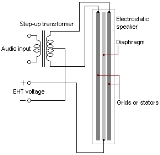
Electrostatic loudspeaker
Overview
Loudspeaker
A loudspeaker is an electroacoustic transducer that produces sound in response to an electrical audio signal input. Non-electrical loudspeakers were developed as accessories to telephone systems, but electronic amplification by vacuum tube made loudspeakers more generally useful...
design in which sound
Sound
Sound is a mechanical wave that is an oscillation of pressure transmitted through a solid, liquid, or gas, composed of frequencies within the range of hearing and of a level sufficiently strong to be heard, or the sensation stimulated in organs of hearing by such vibrations.-Propagation of...
is generated by the force
Force
In physics, a force is any influence that causes an object to undergo a change in speed, a change in direction, or a change in shape. In other words, a force is that which can cause an object with mass to change its velocity , i.e., to accelerate, or which can cause a flexible object to deform...
exerted on a membrane
Acoustic membrane
An acoustic membrane is a thin layer that vibrates and are used in acoustics to produce or transfer sound, such as a drum, microphone, or loudspeaker....
suspended in an electrostatic field.
The speakers use a thin flat diaphragm
Diaphragm (acoustics)
In the field of acoustics, a diaphragm is a transducer intended to faithfully inter-convert mechanical motion and sound. It is commonly constructed of a thin membrane or sheet of various materials. The varying air pressure of the sound waves imparts vibrations onto the diaphragm which can then be...
usually consisting of a plastic sheet coated with a conductive material such as graphite
Graphite
The mineral graphite is one of the allotropes of carbon. It was named by Abraham Gottlob Werner in 1789 from the Ancient Greek γράφω , "to draw/write", for its use in pencils, where it is commonly called lead . Unlike diamond , graphite is an electrical conductor, a semimetal...
sandwiched between two electrically conductive grids, with a small air gap between the diaphragm and grids. For low distortion operation, the diaphragm must operate with a constant charge
Charge (physics)
In physics, a charge may refer to one of many different quantities, such as the electric charge in electromagnetism or the color charge in quantum chromodynamics. Charges are associated with conserved quantum numbers.-Formal definition:...
on its surface, rather than with a constant voltage
Voltage
Voltage, otherwise known as electrical potential difference or electric tension is the difference in electric potential between two points — or the difference in electric potential energy per unit charge between two points...
(charge and voltage are not the same thing).

